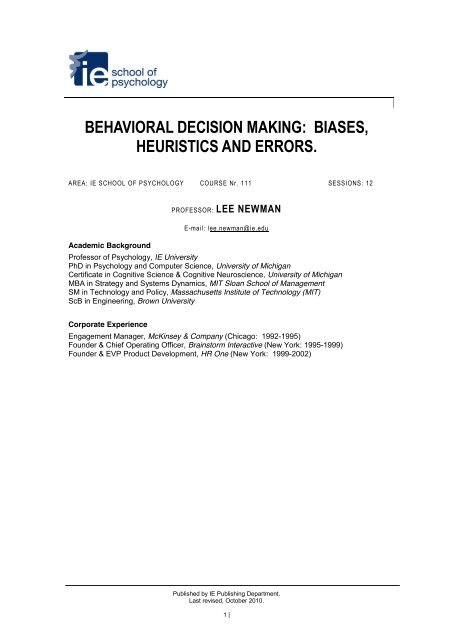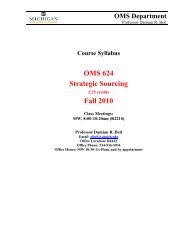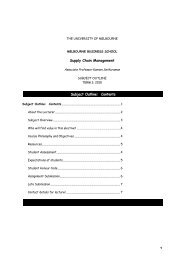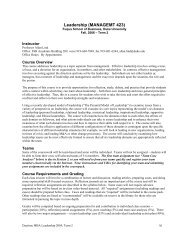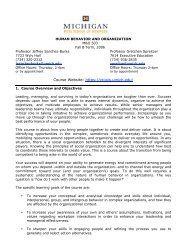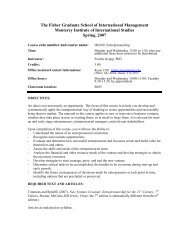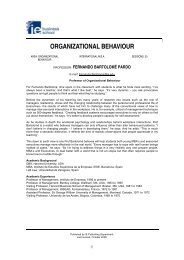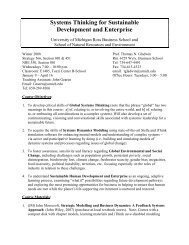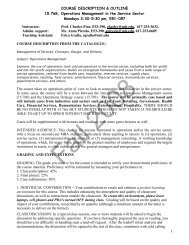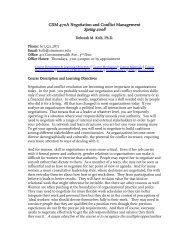behavioral decision making: biases, heuristics and errors.
behavioral decision making: biases, heuristics and errors.
behavioral decision making: biases, heuristics and errors.
Create successful ePaper yourself
Turn your PDF publications into a flip-book with our unique Google optimized e-Paper software.
BEHAVIORAL DECISION MAKING: BIASES,<br />
HEURISTICS AND ERRORS.<br />
AREA: IE SCHOOL OF PSYCHOLOGY COURSE Nr. 111 SESSIONS: 12<br />
Academic Background<br />
PROFESSOR: LEE NEWMAN<br />
E-mail: lee.newman@ie.edu<br />
Professor of Psychology, IE University<br />
PhD in Psychology <strong>and</strong> Computer Science, University of Michigan<br />
Certificate in Cognitive Science & Cognitive Neuroscience, University of Michigan<br />
MBA in Strategy <strong>and</strong> Systems Dynamics, MIT Sloan School of Management<br />
SM in Technology <strong>and</strong> Policy, Massachusetts Institute of Technology (MIT)<br />
ScB in Engineering, Brown University<br />
Corporate Experience<br />
Engagement Manager, McKinsey & Company (Chicago: 1992-1995)<br />
Founder & Chief Operating Officer, Brainstorm Interactive (New York: 1995-1999)<br />
Founder & EVP Product Development, HR One (New York: 1999-2002)<br />
Published by IE Publishing Department.<br />
Last revised, October 2010.<br />
1 |
OBJECTIVES<br />
Motivation: Reasoning, judging <strong>and</strong> deciding are important aspects of everyday life <strong>and</strong> are<br />
particularly critical in the context of business. For example, managers routinely make<br />
<strong>decision</strong>s amid uncertainty <strong>and</strong> too little time; the daily life of the entrepreneur involves kneejerk<br />
judgments, quick <strong>decision</strong>s, <strong>and</strong> often emotional attachments; marketers, consultants <strong>and</strong><br />
financial advisors need to influence by underst<strong>and</strong>ing the behavior of their consumers <strong>and</strong><br />
clients. Research in the <strong>behavioral</strong> sciences has demonstrated convincingly that despite our<br />
best intentions, as <strong>decision</strong> makers we are often prone to err. We are influenced by <strong>biases</strong>,<br />
swayed by em <br />
approaches to <strong>making</strong> <strong>decision</strong>s even when more principled models <strong>and</strong> methods are<br />
available. When do we err How do we err Why do we do so And how can we do better<br />
Focus: Courses in quantitative methods, economics, <strong>and</strong> formal <strong>decision</strong> theory tend to focus<br />
on models that address how we should make <strong>decision</strong>s. In this complementary course, we´ll<br />
focus on underst<strong>and</strong>ing how people actually reason <strong>and</strong> make <strong>decision</strong>s in a variety of<br />
commonly faced business contexts with a focus on situations that involve uncertainty. The<br />
course material is based on empirical findings (often counterintuitive) from research in<br />
cognitive <strong>and</strong> social psychology <strong>and</strong> from closely allied work in <strong>behavioral</strong> economics. A few<br />
of the heroes whose ideas are central to the course are Kahneman, Tversky, Thaler,<br />
Loewenstein, Fischhoff, Camerer, <strong>and</strong> Slovic. This course is designed to be fun <strong>and</strong><br />
accessible; therefore, while there is rigorous psychological <strong>and</strong> economic theory underpinning<br />
all of the topics we will address, our emphasis will be on concepts <strong>and</strong> practical applications<br />
rather than models <strong>and</strong> mathematics * .<br />
Audience <strong>and</strong> goals: The course is intended for a broad audience of future managers,<br />
marketers, consultants, entrepreneurs, or anyone seeking a better underst<strong>and</strong>ing of judgment<br />
<strong>and</strong> <strong>decision</strong> <strong>making</strong> from a <strong>behavioral</strong> perspective. After participating in this course, you<br />
should expect to:<br />
1. Learn to identify the types of situations that pose challenges to our ability to reason <strong>and</strong><br />
make good <strong>decision</strong>s.<br />
2. Recognize important cognitive, emotional <strong>and</strong> social <strong>biases</strong> <strong>and</strong> fundamental limitations<br />
that can influence how we reason <strong>and</strong> decide.<br />
3. ion<br />
<strong>making</strong> <strong>and</strong> the situations in which these lead to good, bad, <strong>and</strong> decidedly ugly outcomes.<br />
4. Learn how we can reason <strong>and</strong> decide more effectively by limiting or avoiding our <strong>biases</strong>,<br />
default approaches, <strong>and</strong> limitations.<br />
5. Underst<strong>and</strong> how <strong>behavioral</strong> concepts from the course apply to business contexts such as<br />
consumer marketing, financial investing, consulting, <strong>and</strong> general management.<br />
Coverage: Behavioral <strong>decision</strong> <strong>making</strong> is a broad subject that can be considered from many<br />
perspectives, not all of which we will have time to address. As such, to help you decide, I<br />
think it is important to be clear on the perspectives <strong>and</strong> topics that will (<strong>and</strong> will not) be<br />
emphasized in this course:<br />
• Decision <strong>making</strong> by individuals. The course focuses on individual <strong>decision</strong> behavior. We<br />
will not cover group <strong>and</strong> organizational <strong>decision</strong> <strong>making</strong>, although we will touch on how<br />
our individual <strong>decision</strong> processes are affected by other people <strong>and</strong> by organizational<br />
context.<br />
• : The course focuses on <strong>decision</strong> contexts typified by lack<br />
of information, uncertain information, <strong>and</strong> limited timeframes. While we may touch on<br />
major strategic or organizational <strong>decision</strong>s made over the<br />
course of months or years this will not be emphasized.<br />
• Behavioral perspectives: Although we will very briefly review normative perspectives on<br />
<strong>decision</strong> <strong>making</strong> in the first session, <strong>and</strong> we will sometimes refer to normative ideas as<br />
benchmarks, this course is about underst<strong>and</strong>ing behavior. Depending on interest, we<br />
<br />
* If you are interested in advanced theory <strong>and</strong>/or models, I am happy to provide you additional readings, <strong>and</strong> you might also choose to<br />
focus your Applications Report on an advanced topic of particular interest to you.<br />
2 |
MATERIALS<br />
The readings will be provided via a course pack <strong>and</strong> these will be the main source of<br />
materials in the course. These readings will include chapters from popular textbooks<br />
addressing managerial judgment <strong>and</strong> <strong>decision</strong> <strong>making</strong>, articles from the psychology <strong>and</strong><br />
<strong>behavioral</strong> economics literatures, <strong>and</strong> articles from the popular press.<br />
METHODOLOGY<br />
The course will rely on a range of methods including discussion-oriented lectures, experiential<br />
<br />
everyone will complete an on-line <strong>behavioral</strong> assessment. This will provide a source of<br />
throughout the course to make <strong>behavioral</strong> concepts<br />
concrete. This data will be augmented by in-class <strong>behavioral</strong> simulations that will offer<br />
additional insights into <strong>decision</strong> <strong>making</strong> challenges, successes <strong>and</strong> failures.<br />
While there will be some variation from session to session, there will be a common format:<br />
1. Situations: We will address one or more commonly faced judgment <strong>and</strong> <strong>decision</strong> <strong>making</strong><br />
(JDM) situations using a mini-experiment, simulation, assessment, or set of readings.<br />
2. Data & Interpretation: We will examine the data from the class <strong>and</strong>/or a set of reference<br />
groups to analyze behavior: how well do people perform in these JDM situations<br />
3. Explanation & Underst<strong>and</strong>ing: We will draw on concepts <strong>and</strong> ideas from the psychology of<br />
judgment <strong>and</strong> <strong>decision</strong> <strong>making</strong> <strong>and</strong> from <strong>behavioral</strong> economics (<strong>and</strong> occasionally,<br />
neuroeconomics) to better underst<strong>and</strong> why people behave as they do.<br />
4. Application<br />
arise in business contexts such as general management, strategy, marketing, finance, <strong>and</strong><br />
entrepreneurship.<br />
5. Improvement<br />
<strong>and</strong> <strong>decision</strong> <strong>making</strong> performance. How can we avoid <strong>biases</strong>, <strong>errors</strong> <strong>and</strong> failures<br />
PROGRAM<br />
In terms of workload, for each session you should expect to read one or two short book<br />
chapters (or chapter excerpts), one or two management-oriented papers, <strong>and</strong> one or two brief<br />
articles from the popular press. To help you determine how much time/effort to put into each<br />
reading, I have marked each reading according to the Key below.<br />
KEY:<br />
[Q] Quick readings, usually from popular press or websites. These are intended to<br />
provide background <strong>and</strong> to get you thinking about real-world situations <strong>and</strong><br />
applications.<br />
[R] Read fully <strong>and</strong> carefully. These are the core readings for the session <strong>and</strong> you<br />
should come to class prepared to talk about them.<br />
[E] Read/skim to Extract primary concepts. These will usually be papers presenting<br />
the results of <strong>behavioral</strong> experiments. Read the Introduction, <strong>and</strong> focus on<br />
extracting main ideas from the Results <strong>and</strong> Discussion sections of the papers.<br />
[X] Extra readings you should consider if the topic is of particular interest to you.<br />
The numbers given after each code in the reading lists below denote the approximate<br />
<br />
3 |
SESSION 1<br />
Introduction to BJDM: Motivations, Definitions, Contexts, <strong>and</strong> Challenges.<br />
Readings<br />
[Q, 3] 2Spare.com. (2006). Top 87 Bad Predictions about the Future<br />
[Q, 5] Irrationality: Rethinking Rationality. (Dec 6, 1999). The Economist.<br />
[Q, 2] Gilbert, D. T. (April 6, 2006). I'm OK, You're Biased, The New York Times.<br />
[Q, 1] Altman, D. (October 10, 2002). A Nobel that bridges economics <strong>and</strong> psychology, The<br />
New York Times.<br />
[Q, 1] Grene, S. (January 3, 2010). More respect for behavioural studies, Financial Times.<br />
[Q, 5]<br />
[R, 6]<br />
Muoio, A. (December 18, 2007). Decisions, <strong>decision</strong>s. Fast Company.<br />
<br />
& Dawes, R. M. (2009). Rational choice in an uncertain world: the psychology of<br />
judgment <strong>and</strong> <strong>decision</strong> <strong>making</strong> (2nd). Thous<strong>and</strong> Oaks, Calif.: Sage Publications.<br />
[R ,4] -S<br />
H., & Moore, D. (2009). Judgment in managerial <strong>decision</strong> <strong>making</strong> (7th). Hoboken, NJ:<br />
J. Wiley & Sons.<br />
[R, 10] Pfeffer, J., & Sutton, R. I. (2006). Evidence-based management. Harvard Business<br />
Review, 84(1), 62-74.<br />
[R, 6] Tingling, P., & Brydon, M. (2010). Is Decision-Based Evidence Making Necessarily<br />
Bad MIT Sloan Management Review, 51(4), 71-76.<br />
[X, 6] Drucker, P. F. (1967). The effective <strong>decision</strong>. Harvard Business Review, 45(1), 92-98.<br />
[X, 6]<br />
(Note: the language is <br />
Dye, R., Sibony, O., & Truong, V. (2008). Flaws in strategic <strong>decision</strong> <strong>making</strong>:<br />
McKinsey Global Survey Results. McKinsey Quarterly.<br />
Questions to Consider<br />
• What sense (if any) do you have that YOU are biased in the way you make judgments<br />
<strong>and</strong> <strong>decision</strong>s<br />
• Think about how you (have) typically approach(ed) analyzing a situation to make a<br />
<strong>decision</strong> or a recommendation at work, particularly in situations where difference of<br />
opinion are likely. How many - <br />
completely open mind An initial preference How do you split your time <strong>and</strong> effort in<br />
terms of looking for confirming <strong>and</strong> disconfirming information<br />
SESSION 2<br />
Probabilistic Reasoning: Snubbing Bayes, Predicting Outcomes & Making Choices.<br />
Readings<br />
Part I: Choosing Among Uncertain Options<br />
[R, 5] The psychology of<br />
judgment <strong>and</strong> <strong>decision</strong> <strong>making</strong>. Philadelphia: Temple University Press.<br />
[E, 9] Lichtenstein, S., & Slovic, P. (1971). Reversals of preference between bids <strong>and</strong><br />
choices in gambling <strong>decision</strong>s. Journal of Experimental Psychology, 89(1), 46-55.<br />
[E, 16] Arkes, H. R., & Blumer, C. (1985). The psychology of sunk cost. Organizational<br />
Behavior <strong>and</strong> Human Decision Processes, 35(1), 124-140.<br />
[Q, 2] Larrick, R. P., & Soll, J. B. (2008). ECONOMICS: The MPG Illusion. Science,<br />
320(5883), 1593-1594.<br />
Part II: Reasoning over Posterior Probabilities<br />
Rule, consider thumbing through your old materials.<br />
[Q, 2] In praise of Bayes. (September 28, 2000). The Economist.<br />
[Q, 2] Modeling Surprise in "10 emerging technologies 2008". (2008). Technology Review,<br />
111(2), 51.<br />
[Q, 1] Gregory, T. H., Lauren, G., Ivan, A., Wade, R., & et al. (2004). 10 emerging<br />
[R, 7]<br />
technologies that will change your world. Technology Review, 107(1), 32.<br />
Sections 5.8 <strong>and</strong> 5.9 in Hastie, R., & Dawes, R. M. (2009). Rational choice in an<br />
uncertain world: the psychology of judgment <strong>and</strong> <strong>decision</strong> <strong>making</strong> (2nd). Thous<strong>and</strong><br />
Oaks, Calif.: Sage Publications.<br />
[E, 22] Bar-Hillel, M. (1980). The base-rate fallacy in probability judgments. Acta<br />
Psychologica, 44(3), 211-233.<br />
[X, 4] Prelec, D. (2004). A bayesian truth serum for subjective data. Science, 306(5695),<br />
462-466. Note: For the more mathematically inclined, an interesting proposal for<br />
reducing judgment bias using Bayesian methods.<br />
4 |
[X, 22] Lichtenstein, S. <strong>and</strong> Fischhoff B. (1980). "Training for calibration." Organizational<br />
Behavior <strong>and</strong> Human Performance 26(2): 149-171. Note: Explores the effects of<br />
training on probabilistic reasoning. If you are interested in consulting or HR, this<br />
paper may be worth a quick read.<br />
Questions to Consider<br />
• Part I: Is car buying problem discussed in the Science article a probabilistic reasoning<br />
task How is it relevant to this topic<br />
• Part II: After the readings you may realize that the Engineers & Lawyers IExperiment, the<br />
Taxicab problem, <strong>and</strong> the Down Syndrome problem from the pre-course questionnaire<br />
(refer to your Questionnaire) are all problems that involve using base rates. People tend<br />
to ignore/underuse base rates in Engineer, Taxicab <strong>and</strong> Down Syndrome problem -- but<br />
for different reasons. How are they different Bar-Hillel suggests several alternative<br />
explanations for why we frequently seem to err by ignoring base rates. What are these<br />
alternatives Which seem more/least compelling In what business contexts could you<br />
see these biased was of reasoning happening, <strong>and</strong> how might you avoid this Any ideas<br />
how this might apply to consumer choice<br />
SESSION 3<br />
Misconceptions of Chance: What Happens in Vegas Should Stay in Vegas.<br />
Readings<br />
[R, 8] Sections 7.3, 7.4, 8.6 an d8,7 in Hastie, R., & Dawes, R. M. (2009). Rational choice<br />
in an uncertain world: the psychology of judgment <strong>and</strong> <strong>decision</strong> <strong>making</strong> (2nd).<br />
Thous<strong>and</strong> Oaks, Calif.: Sage Publications.<br />
[Q, 1] ´Hot H<strong>and</strong>s' phenomenon: A myth (1988, April 19). The New York Times.<br />
[R, 5] Tversky, A., & Gilovich, T. (1989). The cold facts about the 'Hot H<strong>and</strong>' in basketball.<br />
Chance, 2(1), 16-21.<br />
[Q, 6] Wolff, A. (2002, January 21). The cover that no one would pose for: Is the SI jinx for<br />
real Sports Illustrated.<br />
[R, 7] Wainer, H. (2007). The most dangerous equation. American Scientist, 95(3), 249-256.<br />
[Q, 1] Business History Fan. (2007). In Search of Excellence - 25th Anniversary:<br />
Innovation. (Blog Entry)<br />
[X, 26] Joyce, E. J. <strong>and</strong> Biddle G. C. (1981). "Are Auditor's Judgments Sufficiently<br />
Regressive" Journal of Accounting Research 19(2): 323-349.<br />
[X, 10] Koning, R. H. (2003). An econometric evaluation of the effect of firing a coach on<br />
team performance. Applied Economics, 35(5), 555.<br />
[X, 22] Kahneman, D., & Tversky, A. (1972). Subjective probability: A judgment of<br />
representativeness. Cognitive Psychology, 3(3), 430-454.<br />
Questions to Consider<br />
• Hot H<strong>and</strong>: What bias (that we have already discussed) is likely driving at least some of<br />
<br />
(relevant to you) might the Hot H<strong>and</strong> bias/error apply Could this bias work in the<br />
opposite direction, leading people to miss real patterns when they actually are present If<br />
so, in what business contexts <strong>and</strong> how might this happen<br />
• Sample Size Insensitivity: The article focuses on an epidemiological example <strong>and</strong> refers<br />
to a few others. How might you extend this type of bias/error in judgment to<br />
management, business or economic contexts<br />
• Non-<br />
that the blogger, the Booz-Allen consultant, the money manager, Business Week <strong>and</strong> the<br />
writer(s) of the Wikipedia entry all seem to be missing How else might you explain<br />
<br />
between blindly inve<br />
<br />
performance, which would you choose<br />
Conjunctive & Disjunctive Reasoning: Research shows we often err in judging the<br />
<br />
multiple components. To what management <strong>and</strong> business tasks might this <strong>behavioral</strong><br />
finding apply How would it apply <strong>and</strong> what negative outcomes would you predict What<br />
could you do to prevent these outcomes<br />
5 |
SESSION 4<br />
Memory: Decision Making with a Tiny Whiteboard <strong>and</strong> a Low-Fidelity Hard Drive.<br />
Readings<br />
[R, 6] Chapter 3 <strong>and</strong> sections of Chapter 4 from Plous, S. (1993). The psychology of<br />
judgment <strong>and</strong> <strong>decision</strong> <strong>making</strong>. Philadelphia: Temple University Press.<br />
[R, 6] <br />
Rational choice in an uncertain world: the psychology of judgment <strong>and</strong> <strong>decision</strong><br />
<strong>making</strong> (2nd ed.). Thous<strong>and</strong> Oaks, Calif.: Sage Publications.<br />
[R, 8] Tversky, A. <strong>and</strong> Kahneman D. (1982). Availability: A heuristic for judging frequency<br />
<strong>and</strong> probability. In D. Kahneman, P. Slovic <strong>and</strong> A. Tversky (Eds.), Judgment under<br />
uncertainty: <strong>heuristics</strong> <strong>and</strong> <strong>biases</strong> (pp. 163-178). Cambridge ; New York: Cambridge<br />
University Press.<br />
[Q, 1]<br />
[Q, 1]<br />
Public Broadcasting Service. (2010). The public dem<strong>and</strong>s it (Webpage excerpt)<br />
Sunstein, C. R. (2003, May 10). Fear Factor: Truth Is, Sunbathing is Probably More<br />
Dangerous Than Terrorism, Commentray, Los Angeles Times, p. B11.<br />
[R, 4] Kahneman, D., Fredrickson, B. L., Schreiber, C. A., & Redelmeier, D. A. (1993).<br />
When more pain is preferred to less: Adding a better end. Psychological Science,<br />
4(6), 401-405.<br />
[E, 17] Schacter, D. L. (1999). The seven sins of memory. Insights from psychology <strong>and</strong><br />
cognitive neuroscience. American Psychologist, 54(3), 182-203.<br />
Questions to Consider<br />
• What are some practical implications of Primacy, Recency, Hindsight, <strong>and</strong> Halo effects in<br />
the workplace <strong>and</strong> in business practices<br />
• In what real-world contexts might Availability be of particular concern What steps could<br />
-<br />
SESSION 5<br />
Confidence: How Good (We Think) We Are!<br />
Readings<br />
[R, 7] Chapter 19 Overconfidence in Plous, S. (1993). The psychology of judgment <strong>and</strong><br />
<strong>decision</strong> <strong>making</strong>. Philadelphia: Temple University Press.<br />
[R, 8]<br />
Lovallo, D. <strong>and</strong> Kahneman D. (2003). Delusions of success. Harvard Business<br />
Review, 81(7), 56-63.<br />
[R, 10] Russo, J. E. <strong>and</strong> Schoemaker P. J. H. (1992). Managing overconfidence. Sloan<br />
Management Review, 33(2), 7.<br />
[X, 11] Cooper, A. C., Woo C. Y., et al. (1988). Entrepreneurs' perceived chances for<br />
success. Journal of Business Venturing, 3(2), 97-108.<br />
Note: This is study of confidence in 2994 entrepreneurs. Some interesting findings<br />
for those interested in seeing entrepreneurship or in reading about additional realworld<br />
findings of overconfidence.<br />
[X, 12] Koriat, A., Lichtenstein S., et al. (1980). Reasons for confidence. Journal of<br />
Experimental Psychology-Human Learning <strong>and</strong> Memory, 6(2), 107-118.<br />
Note: If you are particularly interested in the topic of confidence, this paper delves<br />
further into some of the possible sources of overconfidence as well as how evidencebased<br />
methods affects levels of confidence.<br />
Questions to Consider<br />
• Try to bring to mind your typical behaviors in situations (professional or personal) in which<br />
you offer your opinion, or make predictions <strong>decision</strong>s. Think through some of these<br />
situations in your mind: Do you see any signs of over- or under-confidence What<br />
time/effort do you put into thinking about the strength of information you consider What<br />
about the weight (importance or credibility) of the information you consider Do you<br />
consider strength <strong>and</strong> weight equally<br />
• What relationships can you identify between Overconfidence <strong>and</strong> other <strong>biases</strong> <strong>and</strong><br />
<strong>heuristics</strong> we have discussed so far in the course Can you identify any interactions<br />
between the various <strong>biases</strong> that might make it even more difficult to calibrate your<br />
confidence<br />
• Either thinking about yourself or people with whom you work, what plausible management<br />
practices could you change or develop to try to avoid overconfidence<br />
6 |
SESSION 6<br />
<br />
Readings<br />
[Q, 1] Finance <strong>and</strong> Economics: Carrots dressed as sticks; Designing rewards. (2010). The<br />
Economist, 394(8665), 72.<br />
[Q, 2] Goode, E. (2001, January 9). In Weird Math of Choices, 6 Choices Can Beat 600,<br />
[Q, 2]<br />
The New York Times.<br />
Johnson, E. J., & Goldstein, D. G. (2003). Medicine - Do defaults save lives Science,<br />
302(5649), 1338-1339.<br />
[R, 10] Chapter 4 Framing <strong>and</strong> Reversal in Bazerman, M. H., & Moore, D. (2009). Judgment<br />
in managerial <strong>decision</strong> <strong>making</strong> (7th ed.). Hoboken, NJ: J. Wiley & Sons.<br />
[R, 16] Chapter 2 in Belsky, G., & Gilovich, T.<br />
(2010). Why smart people make big money mistakes...<strong>and</strong> how to correct them:<br />
Lessons from the life-changing science of <strong>behavioral</strong> economics (Simon & Schuster<br />
ed.). New York: Simon & Schuster Paperbacks<br />
[X, 12] Chapter 5 Dropping Anchor in Belsky, G., & Gilovich, T. (2010). Why smart people<br />
make big money mistakes...<strong>and</strong> how to correct them: Lessons from the life-changing<br />
science of <strong>behavioral</strong> economics (Simon & Schuster ed.). New York: Simon &<br />
Schuster Paperbacks<br />
Questions to Consider<br />
• What relationship do you see (if any) between the Anchoring <strong>and</strong> Adjustment heuristic<br />
<strong>and</strong> other <strong>heuristics</strong> <strong>and</strong> <strong>biases</strong> we have covered so far in the course<br />
• How are Framing Effects <strong>and</strong> the Anchoring <strong>and</strong> Adjustment heuristic consistent with<br />
Prospect Theory<br />
• In what ways can you see (have you seen) Framing being used beneficially on the job in<br />
your area of work What about negative effects<br />
SESSION 7<br />
The 13 th Floor: Causes, Effects <strong>and</strong> Associations between (un)Related Events.<br />
Readings<br />
[Q, 4] Belkin, L. (2002, August 11). The Odds of That, New York Times.<br />
[R, 6] Chapter 15 Correlation, Causation <strong>and</strong> Control in Plous, S. (1993). The psychology of<br />
judgment <strong>and</strong> <strong>decision</strong> <strong>making</strong>. Philadelphia: Temple University Press.<br />
[R, 7] Chapter 16 Attribution Theory in Plous, S. (1993). The psychology of judgment <strong>and</strong><br />
<strong>decision</strong> <strong>making</strong>. Philadelphia: Temple University Press.<br />
[E, 13] Chapter Conclusion in Fung, K. (2010). Numbers rule your world: The hidden<br />
influence of probability <strong>and</strong> statistics on everything you do. New York: McGraw-Hill.<br />
[X, 5] Gmelch, G. (1978). Baseball Magic. Human Nature, 1(8), 32-39.<br />
[X, 17] Langer, E. J. (1975). The illusion of control. Journal of Personality <strong>and</strong> Social<br />
Psychology, 32(2), 311-328.<br />
Questions to Consider<br />
• <br />
debias yourself <strong>and</strong> avoid <strong>errors</strong>. Two important steps are: (1) forcing yourself to<br />
generate <strong>and</strong> analyze multiple hypotheses (ideas, explanations, proposals) <strong>and</strong> (2)<br />
collecting <strong>and</strong> considering both confirmatory <strong>and</strong> disconfirmatory data <strong>and</strong> facts. If you<br />
consider your own "thinking" as "data" (a good idea), what do the readings for this<br />
session suggest you should worry about in using this "mental data" as part of your JDM<br />
process What are our <strong>biases</strong> in "thinking" <strong>and</strong> how can we avoid them<br />
7 |
SESSION 8<br />
The Role of Expertise & Intuition in JDM: Trusting, Ignoring, <strong>and</strong> Exploring your Gut.<br />
Readings<br />
[Q, 5] Sunstein, C. R., & Thaler, R. (2003, September 1). Who's on First The New<br />
Republic.<br />
[R,10] Kahneman, D., & Klein, G. (2009). Conditions for Intuitive Expertise: A Failure to<br />
Disagree. American Psychologist, 64(6), 515-526.<br />
[R, 6] Hayashi, A. M. (2001). When to TRUST Your GUT. Harvard Business Review, 79(2),<br />
59-65.<br />
[R, 2] Klein, G. (2007). Performing a project premortem. Harvard Business Review, 85(9),<br />
18-19.<br />
[X, 18] Dane, E., & Pratt, M. G. (2007). Exploring intuition <strong>and</strong> its role in managerial <strong>decision</strong><br />
<strong>making</strong>. Academy of Management Review, 32(1), 33-54.<br />
[X, 11] Miller, C. C., & Irel<strong>and</strong>, R. D. (2005). Intuition in strategic <strong>decision</strong> <strong>making</strong>: Friend or<br />
foe in the fast-paced 21(st) century Academy of Management Executive, 19(1), 19-<br />
30.<br />
Questions to Consider<br />
• What is expertise, how do we get it, <strong>and</strong> how do we use it<br />
• What is the difference between expertise <strong>and</strong> intuition Do you think intuition is related to<br />
expertise or something completely different<br />
• In what ways do Kahneman, Klein, <strong>and</strong> Hayashi agree <strong>and</strong> disagree about the role of<br />
<br />
• The next time you are trying to make a <strong>decision</strong> <strong>and</strong> your intuition seems to favor one<br />
option over others, what will you do<br />
SESSION 9<br />
Emotion <strong>and</strong> Intertemporal Choice: What We (Think We) Feel <strong>and</strong> Time Traveling in JDM.<br />
Readings<br />
[Q, 3] Carey, B. (2010, July 5). The benefits of blowing your top, The New York Times.<br />
[R, 8] Chapter 5 Motivational <strong>and</strong> Emotional Influences on Decision Making in Bazerman,<br />
M. H., & Moore, D. (2009). Judgment in managerial <strong>decision</strong> <strong>making</strong> (7th). Hoboken,<br />
NJ: J. Wiley & Sons.<br />
[R, 3] A framework excerpted from Loewenstein, G., & Lerner, J. S. (2003). The role of<br />
affect in <strong>decision</strong> <strong>making</strong>. In R. Davidson, H. Goldsmith & K. Scherer (Eds.),<br />
H<strong>and</strong>book of Affective Science (pp. 619-642). New York: Oxford University Press.<br />
[R, 3] Gilbert, D. T. <strong>and</strong> Wilson T. D. (2007). Prospection: Experiencing the Future. Science,<br />
317(5843), 1351-1354.<br />
[R, 4] Tversky, A. <strong>and</strong> Shafir E. (1992). Choice under conflict: The dynamics of deferred<br />
[E, 8]<br />
<strong>decision</strong>. Psychological Science, 3(6), 358-361.<br />
Chapter 10 Judgment <strong>and</strong> Choice Across Time in Hardman, D. (2009). Judgment <strong>and</strong><br />
<strong>decision</strong> <strong>making</strong>. Malden, MA: Wiley-Blackwell.<br />
[X, 7] Chapter 32 Preferences for Sequences of Outcomes in Kahneman, D. <strong>and</strong> Tversky A.<br />
(2000). Choices, values, <strong>and</strong> frames. New York: Cambridge University Press.<br />
[X, 24] Loewenstein, G., & Lerner, J. S. (2003). The role of affect in <strong>decision</strong> <strong>making</strong>. In R.<br />
Davidson, H. Goldsmith & K. Scherer (Eds.), H<strong>and</strong>book of Affective Science (pp. 619-<br />
642). New York: Oxford University Press.<br />
Questions to Consider<br />
• What is an emotion How is an emotion different from thinking about emotions Can<br />
emotions arise from thinking about emotions In what stages <strong>and</strong> ways can emotion<br />
influence judgment <strong>and</strong> <strong>decision</strong> processes Can emotions play a useful role in JDM<br />
should they be avoided<br />
• -<br />
are prone to bias. What are these <strong>biases</strong> <strong>and</strong> how might we avoid them<br />
• Reconstructing the past using our memory <strong>and</strong> simulating the future are both mental<br />
processes that involve reasoning across time. Looking back at the many <strong>biases</strong> <strong>and</strong><br />
<strong>heuristics</strong> that we have discussed in the course, in which do you see an important role of<br />
time<br />
• According to the Tversky & Shafir paper <strong>and</strong> the Hardman chapter, what are some ways<br />
in which time enters into JDM<br />
8 |
SESSION 10<br />
Mental Accounting, the Pursuit of Happiness, <strong>and</strong> other topics.<br />
[E, 14] Thaler, R. (2000). Mental Accounting Matters. In D. Kahneman & A. Tversky (Eds.),<br />
Choices, values, <strong>and</strong> frames (pp. 241-268). New York: Cambridge University Press.<br />
[R, 3] Kahneman, D., Krueger, A. B., Schkade, D., Schwarz, N., & Stone, A. A. (2006).<br />
Would You Be Happier If You Were Richer A Focusing Illusion. Science, 312(5782),<br />
1908-1910.<br />
[R, 6] Hsee, C. K., & Hastie, R. (2006). Decision <strong>and</strong> experience: why don't we choose what<br />
makes us happy Trends in Cognitive Sciences, 10(1), 31-37.<br />
[X, 16] Richard, T. (1985). Mental Accounting <strong>and</strong> Consumer Choice. Marketing Science,<br />
4(3), 199-214.<br />
Questions to Consider<br />
• <br />
• What examples of mental accounts are covered in the reading <strong>and</strong> how do you see these<br />
accounts affecting JDM behavior in business <strong>and</strong> management contexts As a marketing<br />
<strong>and</strong>/or as a manager, what practices could you implement to take advantage of mental<br />
accounting in consumer behavior <strong>and</strong> the behavior of your co-workers<br />
• Making judgments <strong>and</strong> <strong>decision</strong>s about your own career <strong>and</strong> personal life is of obvious<br />
importance, as is careful consideration of how your <strong>decision</strong>s affect the satisfaction <strong>and</strong><br />
happiness of others. What <strong>biases</strong> <strong>and</strong> challenges are raised in the readings Are any of<br />
the other <strong>biases</strong> that we have discussed relevant in the context of <strong>making</strong> life <strong>decision</strong>s<br />
What steps might you take to debias your important life <strong>decision</strong>s<br />
SESSION 11<br />
Are You Ready for JDM Integrations, Prescriptions <strong>and</strong> Conclusions.<br />
[Q,1] Ticking off: Cutting down on <strong>errors</strong>. (2010). The Economist, 394, 84.<br />
[Q,5]<br />
[Q,4]<br />
Muoio, A. (2007, December 18). Decisions, Decisions. Fast Company.<br />
Hopkins, M. S., & McAfee, A. (2010). Putting the Science in Management Science.<br />
MIT Sloan Management Review, 51(4), 77-82.<br />
[Q,10] How we do it: Three executives reflect on strategic <strong>decision</strong> <strong>making</strong>. (2010). The<br />
McKinsey Quarterly.<br />
[R, 10] Bazerman, M. H., & Moore, D. (2009). Improving Decision Making. In Judgment in<br />
managerial <strong>decision</strong> <strong>making</strong> (7th ed., pp. 179-199). Hoboken, NJ: J. Wiley & Sons.<br />
[R, 10] Lovallo, D., & Sibony, O. (2010). The case for <strong>behavioral</strong> strategy. The McKinsey<br />
Quarterly (2), 1-14.<br />
[X, 6] Chase, R. B., & Dasu, S. (2001). Want to Perfect Your Company's Service Use<br />
Behavioral Science. Harvard Business Review, 79(6), 78-84.<br />
Questions to Consider<br />
• This course has shown over <strong>and</strong> over (<strong>and</strong> over) just how susceptible we are to <strong>biases</strong> in<br />
judgment <strong>and</strong> <strong>decision</strong> <strong>making</strong> in the relatively simple types of judgments <strong>and</strong> <strong>decision</strong>s<br />
we used in the course. After reading the Fast Company <strong>and</strong> McKinsey interviews <strong>and</strong><br />
studies, do you think you (<strong>and</strong> everyone else) are more or less likely to be affected by<br />
bias in the types of complex tasks found in real business <strong>and</strong> management contexts<br />
better real-world JDM using what you have learned int his<br />
course<br />
• If there is bottom-line value to be created by debiasing individual <strong>and</strong> team JDM, why<br />
<br />
personal <strong>and</strong>/or team processes could you put in place to improve JDM outcomes<br />
SESSION 12<br />
Final Exam<br />
9 |
EVALUATION CRITERIA<br />
Final evaluation will be based on (1) class participation (presence, level of preparation <strong>and</strong><br />
contribution to the discussion of simulations, experiments, <strong>and</strong> readings), (2) an Application<br />
Report that applies one or more ideas from <strong>behavioral</strong> <strong>decision</strong> <strong>making</strong>/<strong>behavioral</strong> economics<br />
to a real-world business context of your choosing, <strong>and</strong> (3) performance on a final exam.<br />
• Class participation 10%<br />
• Application Report 40%<br />
• Exam 50%<br />
BIBLIOGRAPHY<br />
The following are the books from which chapters in the course readings are drawn.<br />
Baron, J. (2008). Thinking <strong>and</strong> deciding (4th ed.). New York: Cambridge University Press.<br />
Bazerman, M. H., & Moore, D. (2009). Judgment in managerial <strong>decision</strong> <strong>making</strong> (7th ed.).<br />
Hoboken, NJ: J. Wiley & Sons.<br />
Belsky, G., & Gilovich, T. (2010). Why smart people make big money mistakes...<strong>and</strong> how to<br />
correct them: Lessons from the life-changing science of <strong>behavioral</strong> economics (Simon &<br />
Schuster ed.). New York: Simon & Schuster Paperbacks.<br />
Davidson, R., Goldsmith H. & Scherer K. (Eds.), H<strong>and</strong>book of Affective Science. New York:<br />
Oxford University Press.<br />
Fung, K. (2010). Numbers rule your world: The hidden influence of probability <strong>and</strong> statistics<br />
on everything you do. New York: McGraw-Hill.<br />
Gilovich, T., Griffin, D. W., & Kahneman, D. (2002). Heuristics <strong>and</strong> <strong>biases</strong>: The psychology of<br />
intuitive judgment. Cambridge: Cambridge University Press.<br />
Glimcher, P. W. (2008). Neuroeconomics: Decision <strong>making</strong> <strong>and</strong> the brain. London: Academic<br />
Press.<br />
Hardman, D. (2009). Judgment <strong>and</strong> <strong>decision</strong> <strong>making</strong>. Malden, MA: Wiley-Blackwell.<br />
Hastie, R., & Dawes, R. M. (2009). Rational choice in an uncertain world: The psychology of<br />
judgment <strong>and</strong> <strong>decision</strong> <strong>making</strong> (2 nd ). Thous<strong>and</strong> Oask: Sage Publications.<br />
Kahneman, D., Slovic, P., & Tversky, A. (1982). Judgment under uncertainty: <strong>heuristics</strong> <strong>and</strong><br />
<strong>biases</strong>. Cambridge ; New York: Cambridge University Press.<br />
Kahneman, D., & Tversky, A. (2000). Choices, values, <strong>and</strong> frames. Cambridge: Cambridge<br />
University Press.<br />
Plous, S. (1993). The psychology of judgment <strong>and</strong> <strong>decision</strong> <strong>making</strong>. Philadelphia: Temple<br />
University Press.<br />
BOOKS OF INTEREST<br />
Comprehensive, More Academic <strong>and</strong> Behavioral Economics<br />
Baron, J. (2008). Thinking <strong>and</strong> deciding (4th ed.). New York: Cambridge University Press.<br />
Beach, L. R., & Connolly, T. (2005). The Psychology of Decision Making: People in<br />
Organizations (2 nd ). Thous<strong>and</strong> Oaks: Sage Publications.<br />
Gilovich, T., Griffin, D. W., & Kahneman, D. (2002). Heuristics <strong>and</strong> <strong>biases</strong>: The psychology of<br />
intuitive judgment. Cambridge: Cambridge University Press.<br />
Glimcher, P. W. (2008). Neuroeconomics: Decision Making <strong>and</strong> the Brain. London: Academic.<br />
Hastie, R., & Dawes, R. M. (2009). Rational choice in an uncertain world: The psychology of<br />
judgment <strong>and</strong> <strong>decision</strong> <strong>making</strong> (2 nd ). Thous<strong>and</strong> Oask: Sage Publications.<br />
Hogarth, R. (1987). Judgment <strong>and</strong> Choice (2 nd ). New York: J. Wiley.<br />
Kahneman, D., Slovic, P., & Tversky, A. (1982). Judgment under uncertainty: <strong>heuristics</strong> <strong>and</strong><br />
<strong>biases</strong>. Cambridge ; New York: Cambridge University Press.<br />
Kahneman, D., & Tversky, A. (2000). Choices, values, <strong>and</strong> frames. Cambridge: Cambridge<br />
University Press.<br />
March, J. G., & Heath, C. (2009). A Primer on Decision Making: How Decisions Happen. New<br />
York: Free Press.<br />
Newell, B. R., Lagnado, D. A., & Shanks, D. R. (2007). Straight Choices: The Psychology of<br />
Decision Making. New York: Psychology Press.<br />
10 |
Plous, S. (1993). The psychology of judgment <strong>and</strong> <strong>decision</strong> <strong>making</strong>. Philadelphia: Temple<br />
University Press.<br />
Thaler, R. H. (1992). The Winner's Curse: Paradoxes <strong>and</strong> Anomalies of Economic Life. New<br />
York: Free Press.<br />
Managerial & More Practice-Oriented<br />
Bazerman, M. H., & Moore, D. (2009). Judgment in managerial <strong>decision</strong> <strong>making</strong> (7th ed.).<br />
Hoboken, NJ: J. Wiley & Sons.<br />
Hammond, J. S., Keeney, R. L., & Raiffa, H. (1999). Smart choices: A Practical Guide to<br />
Making Better Decisions. Boston: Harvard Business School Press.<br />
Russo, J. E., & Schoemaker, P. J. H. (2002). Winning Decisions: Getting It Right the First<br />
Time. New York: Currency.<br />
Hoch, S. J., Kunreuther, H., & Gunther, R. E. (2001). Wharton on <strong>making</strong> <strong>decision</strong>s. New<br />
York: Wiley.<br />
JDM in the Context of Consumer Psychology & Behavior<br />
Blackwell, R. D., Miniard P. W., et al. (2006). Consumer behavior (10th ed.). Mason, Ohio:<br />
Thomson Business <strong>and</strong> Economics.<br />
Peter, J. P. <strong>and</strong> Olson J. C. (2010). Consumer behavior & marketing strategy (9th ed.). New<br />
York: McGraw-Hill Irwin.<br />
Underhill, P. (2009). Why we buy: the science of shopping (Updated <strong>and</strong> rev. ed.). New York:<br />
Simon & Schuster Pbks.<br />
Zaltman, G. (2003). How customers think: essential insights into the mind of the market.<br />
Boston, Mass.: Harvard Business School Press.<br />
JDM For Fun<br />
Ariely, D. (2008). Predictably irrational: The hidden forces that shape our <strong>decision</strong>s (1st). New<br />
York: Harper.<br />
Ariely, D. (2010). Perfectly irrational: The unexpected ways we defy logic at work <strong>and</strong> at<br />
home. New York: Harper.<br />
Belsky, G., & Gilovich, T. (2010). Why smart people make big money mistakes...<strong>and</strong> how to<br />
correct them: Lessons from the life-changing science of <strong>behavioral</strong> economics (Simon &<br />
Schuster ed.). New York: Simon & Schuster Paperbacks.<br />
Cialdini, R. B. (2009). Influence : science <strong>and</strong> practice (5th ed.). Boston: Pearson Education.<br />
Fung, K. (2010). Numbers rule your world: The hidden influence of probability <strong>and</strong> statistics<br />
on everything you do. New York: McGraw-Hill.<br />
11 |


